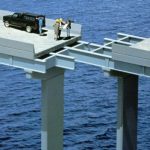- Troubled Projects – The recognition and management of Troubled Projects represent one of the most unique situations in the spectrum of project management challenges. Specialized skills and approaches are required in order to achieve successful outcomes. M&M will post a series of observations and recommendations regarding the recognition, recovery and resolution associated with Troubled Projects.
- Troubled Projects –A Troubled Project may be considered as being a project that may not achieve a successful outcome. Modern project success criteria centers on project completion / delivery that is: Within allocated time duration; within budgeted costs; Achieving requisite performance level(s); and is Acceptable to the Customer / Buyer.
- Troubled Projects –A Troubled Project is expected to, forecasted to, or otherwise may not achieve one or more of the project’s success criteria / objectives. Typical success criteria are project completion / delivery that is: Within allocated time duration; within budgeted costs; Achieving requisite performance level(s); and is Acceptable to the Customer / Buyer.
- Troubled Projects – Call to Action Basically, a Troubled Project is one that is reasonably expected to not achieve its Business Case objectives. Managerial action is needed to enhance the possibility of achieving these Business Case objectives. This managerial action may be summarized is the three R’s – Recognition, Recovery and Resolution.
- Troubled Projects – Leading Indicators Recognition process should begin with leading indicators. Some leading indicators – Criticisms by Key Stakeholders, High Turnover of Key Stakeholders, Untimely / Late Decision Making, Poor Morale, Working Excessive Hours (other than occasionally), and / or Frequent Crisis Management.
- Troubled Projects – Leading Indicators Recognition process should begin with leading indicators. More leading indicators – Labor Peak Greater than Planned, Labor Peak Later than Planned, Unexpectedly High Field Labor Turnover, Negative Cash Flow, Billing / Invoicing Less than Planned, and / or Construction Support Expenditures Greater than Planned.
- Troubled Projects – Leading Indicators Recognition process should begin with leading indicators. Even more leading indicators – Trending / Forecasting not in use, illogical, highly optimistic, unrealistic; Baselines not in use; Commodity consumption exceeding planned; Meetings are combative; Unwillingness to accept responsibility; and / or Poor change management.
- Troubled Projects – Recognition There is urgency in the timeliness of recognition. Early recognition and action increases the quality of Recovery (remember – Recognition, Recovery and Resolution) options and potential results. Like many project challenges – “Find IT early, Fix IT fast.”
- Troubled Projects – Recognition From leading indicators, segway into more quantitate project Key Performance Indicators (KPI’s). Use all KPI’s together (not individual KPI’s) to consider whether trouble exists. There are about five: Schedule (usually CPM), Progress Curves (rate of progress), Productivity (key labor groups), Scope of Work and Total Labor per month.
- Troubled Projects – Recognition The transition from Recognition to Recovery is the “trick.” Recovery – Mastering the Art of the Achievable. Unrealistic / Excessively Optimistic recovery plans and actions are poison. Recovery plans that lack ambition and aggressiveness are vulnerable to criticism. Key attributes – Integrity, Leadership, Courage and Prayer.
- Troubled Projects – Recovery The three R’s when Managing Troubled Projects are Recognition, Recovery and Resolution. Recognition and Recovery are addressed in Project Recovery, a highly authoritative publication authored by Dr. Harold Kerzner. Dr. Kerzner provides a complete process and relates it to Project Management Institute (PMI) managerial process.
- Troubled Projects – Recovery As discussed in and earlier post, the full set of KPI’s are needed. Often, some are missing or not used. If KPI’s are missing, build the missing KPI’s by reverse engineering using available data and that can be efficiently accessed. Build the KPI from present back to start of the project. Do not delay other actions – work concurrently.
- Troubled Projects – Recovery Analyses of the KPI’s combined with project assessments will reveal the path forward for recovery. Once the path has been identified and planned, rebaseline the KPI’s such that meaningful managerial feedback can be achieved. For the one or two KPI’s that reveal recovery status and progress, shorten the reporting period (e.g. monthly to weekly).
- Troubled Projects – The recognition and management of Troubled Projects represent one of the most unique situations in the spectrum of project management challenges. Specialized skills and approaches are required in order to achieve successful outcomes. M&M will continue to post a series of observations and recommendations regarding the recognition, recovery and resolution associated with Troubled Projects.
- Troubled Projects – Call to Action Basically, a Troubled Project is one that is reasonably expected to not achieve its Business Case objectives. Managerial action is needed to enhance the possibility of achieving these Business Case objectives. This managerial action may be summarized is the three R’s – Recognition, Recovery and Resolution.
- Troubled Projects – Recognition From leading indicators (see earlier posts), segway into more quantitate project Key Performance Indicators (KPI’s). Use all KPI’s together (not individual KPI’s) to consider whether trouble exists. There are about five: Schedule (usually CPM), Progress Curves (rate of progress), Productivity (key labor groups), Scope of Work and Total Labor per month.
- Troubled Projects – Owners and Major Disruptions – The world is in the midst of major disruptions to capital projects. Projects are being delayed, postponed, suspended, cancelled and otherwise seriously impacted. As owners consider the path forward, they first are compelled to consider putting their investment into a suitable status for the “hold” period (without knowing the length of the “hold”). Putting the project on hold involves creating stability and closure (temporary or permanent) with all major stakeholders.
TROUBLED PROJECTS
CAPITAL PROJECTS COST CONTROL
In light of the 2017-2018 Construction Forecasts, Capital Projects Cost Control is paramount and one to take a more acute focus.
In Project Execution, Field Labor Shortages Represent The Highest Risk To Achievement Of Time & Cost Objectives Large And Complex Projects.
Major Shortages in Construction Field Labor Will Influence (Negatively) US Construction Costs.
In Execution (After Stage Gate Three), A Major Risk to Project Cost Management Resides in Labor Cost (overruns),
The Highest Risk to Achieving Project Cost Management Occurs In Execution – After Stage Gate Three/Full Funding.
Driven By A Long History of Cost and Schedule Overruns, Managerial Thinking Now Prioritizes Cost Certainty.
On Complex Capital Projects, Cost Certainty Has Become a Compelling Objective.
McLaughlin & McLaughlin has assisted numerous Major Capital Projects successfully over the years by providing cost effective business solutions and recovery plans.
What makes McLaughlin & McLaughlin unique from the others is that we not only perform project management services but dispute resolution as practitioners.
It is important to note that McLaughlin and McLaughlin Project and Dispute Consulting LLC [M&M] is not a law firm and is not intending to provide legal advice. M&M is a consulting firm providing (among other services) non-legal expertise in construction claims, dispute resolution and litigation support. For further information on M&M services, please see www.McLaughlinandMcLaughlin.com.
LABOR OVERRUNS
As the increase of projected Major Capital Projects for 2017-18 emerge with all its implications troubled projects are a likely result. LABOR OVERRUNS are a typical component in troubled projects.
LABOR OVERRUNS – impact several project baselines. Cost, Schedule and Progress are at risk.
LABOR OVERRUNS – Labor Overruns are a major risk in any project with a significant labor component.
LABOR OVERRUNS – Early detection, correction and management require use of proper KPI’s.
LABOR OVERRUNS – Use of thoughtful KPI’s facilitate early/proactive corrective action.
LABOR OVERRUNS – Labor Shortages in 2017 and beyond will lead to upward pressure in labor rates.
LABOR OVERRUNS – Labor shortages in 2017 and beyond will lead a man-hour overruns (poor productivity).
McLaughlin & McLaughlin has assisted numerous troubled Major Capital Projects successfully over the years by providing cost effective business solutions and recovery plans.
It is important to note that McLaughlin and McLaughlin Project and Dispute Consulting LLC [M&M] is not a law firm and is not intending to provide legal advice. M&M is a consulting firm providing (among other services) non-legal expertise in construction claims, dispute resolution and litigation support. For further information on M&M services, please see www.McLaughlinandMcLaughlin.com.
Labor Productivity Problem Recognition
Project Professionals a blog by McLaughlin & McLaughlin Project and Dispute Consulting LLC will be offering a few project tips over the next few weeks.
Today’s focus lists a few key points to recognizing the problems associated with Labor Productivity issues. Problems from the issues may lead to owners and contractors achieving cost uncertainty and schedule uncertainty.
- Negative Cash Flow on Project/Contract/Job.
- Labor Force (Histogram) Peak Later Than Planned.
- Field Labor (Crew Size) Peak Greater than Planned.
- Low Quantities Installed Per Man-Hour Actual/Expended.
- Abnormally/Unexpectedly High Field Labor Turnover Rate.
- Billing less than Planned.
- High Number of New Revisions to Scope Documents.
It is important to note that McLaughlin and McLaughlin Project and Dispute Consulting LLC [M&M] is not a law firm and is not intending to provide legal advice. M&M is a consulting firm providing (among other services) non-legal expertise in construction claims, dispute resolution and litigation support. For further information on M&M services, please see www.McLaughlinandMcLaughlin.com.
https://twitter.com/McLaughProject
https://www.facebook.com/McLaughlin-McLaughlin-Project-and-Dispute-Consulting-LLC-134974839908446/



